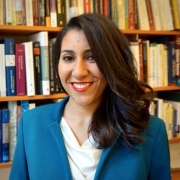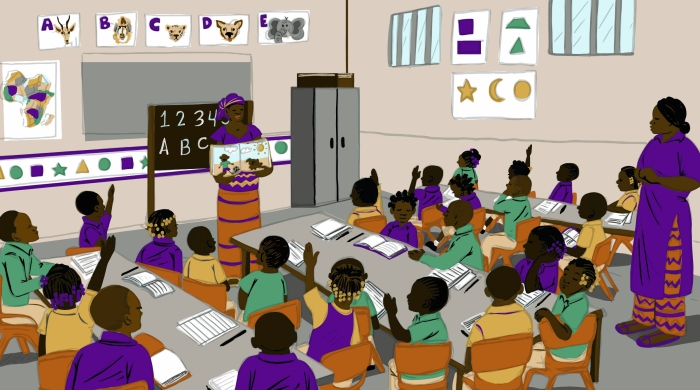Written by Tanya Smith-Sreen and Joyce Rafla
Introduction
Why is it that some countries fluoridate their water? In the mid-20th century, fluoride became linked with reduced tooth decay, sparking a scientific revolution in the dentistry world, and causing cities to begin infusing their water supplies with fluoride. Today, countries add fluoride as a protective factor, as a way to promote healthy early childhood development (ECD). But there is still significant debate around the practice. What if the protective factors we think we know aren’t so protective after all? With ECD interventions expanding from physical development to cognitive and socioemotional development, we must confront the undercurrents of the field. We need to be asking, what’s in the water? Why is it there?
Current Landscape
The integration of ECD into the sustainable development goals (SDGs) in 2016 helped shine a global spotlight on parenting programs. From this hotbed of attention, we saw a wave of programming, research, and advocacy take off, like the Lancet series, publishing the much-cited figure of 250 million children in low-and middle-income countries (LMICs) not reaching their developmental potential. In 2018, the Nurturing Care Framework (NCF) was launched, outlining a set of “five interrelated and indivisible components,” to help children reach their full developmental potential, including good health, adequate nutrition, responsive caregiving, safety & security, and opportunities for early learning. They make up part of the ocean of evidence flowing into many of the positive parenting programs and ongoing research we see today. But what came before the wave? How do we understand where we are without understanding where we came from?
Attachment Theory & Parenting Programs
Many positive parenting practices, core to contemporary parenting programs, are derived from attachment theory. An ethological theory developed by British psychologist, John Bowlby, and built on by American-Canadian psychologist, Mary Ainsworth, in the 1940s onwards, attachment theory foregrounds attachment with a caregiver, particularly the mother, as a vital piece to children’s development.
Today, with the increase in attention to parenting, there has been a proliferation of parenting models worldwide. Attachment-based parenting has become a global benchmark for quality care. However, this compounding diffusion of parenting programs has caused researchers to raise important ethical critiques:
- Many parenting programs force a Western, suburban lifestyle on low-income communities that are usually rural and subsistence living and not heavily rooted in an individualistic urban life;
- Before any organization can step in and propose a parenting intervention that would “improve” parenting, we need to start by developing more knowledge about various cultural and other everyday traditions related to caregiving in specific LMICs and among the range of cultural, ethnic, and linguistic groups within them;
- By adapting programs from WEIRD contexts for parents from LMICs we may be unintentionally stigmatizing their existing funds of knowledge and ways of caregiving and assuming that parenting interventions that have been developed and tested in high-income countries would yield the same results in other contexts.
While there is plenty of evidence to support responsive stimulation, the history of attachment theory provokes questions around the compatibility of attachment-based parenting with certain contexts, alongside other concerns. Starting with World Health Organization-commissioned maternal separation research, Bowlby led much of the foundational research on attachment theory following World War II. In 1964, Ainsworth came up with a procedure considered transformative in operationalizing evidence-building for attachment theory: the Strange Situation.
In the Strange Situation study children were observed for 20 minutes with their mother, alone, and with a stranger to explore their behavior. The results informed the attachment styles that are widely recognized today and the nurturing care central to the design of many parenting programs.
Less known is the barrage of criticism of the Strange Situation approach. From questions around the biological basis of the theory to major methodological concerns, attachment theory and the empirical evidence in which it is grounded has faced considerable pushback. Some researchers saw the Strange Situation as ignoring the role of context in child development, whereas others cite the small sample sizes and lack of inter-rater reliability as concerns in the data supporting attachment theory.
As we continue to ride the wave propelling the increased prioritization of parenting programs, we need to engage in these critical reflections around the possible assumptions embedded into leading frameworks. Spurring that reflection requires an awareness of the basis of these frameworks, as well as the existing critiques.

In reporting about parents' parenting, we should place more responsibility on the systems in which they're operating…These recommendations, if implemented, should redirect donors' attention from investing in impact evaluations to investing in contextually and culturally relevant knowledge creation.
What’s Next?
Situating knowledge generation, whether empirical or theoretical, into the historical backdrop in which it took place is key to understanding what’s in the water. And as researchers, practitioners, policymakers, and more, working with families and children, we can’t fulfill our ethical commitments when operating in murky water. To honor the principles of respect, beneficence, and justice that underpin ethical research and practice, we need clarity on the forces that shaped where we are today. And perhaps we also need new ways to capture the diverse and dynamic caregiving experiences across the world, deeply rooted in cultural context. Perhaps we need new metaphors.
Reframing the metaphors underpinning our work requires intentional shifts in how we think about knowledge generation alongside program planning. These are not new concepts. Age-old calls to decolonize methodologies and honor indigenous ways of knowing persist in more recent recommendations to center co-creation processes in the design and evaluation of global ECD interventions. And although the majority of the 250 million children worldwide at risk of not meeting their developmental potential live in LMICs, more than two-thirds of ECD evaluations conducted in LMICs since 2000 were led by authors based outside those countries.
We need a more diverse body of research and more diverse researchers to shape programming. To do this we propose the following:
- Drawing from samples outside of WEIRD (western, educated, industrialized, rich, democratic) contexts to build theory and develop measures.
- Using these measures and theories to shape research designs in LMICs evaluating why, how, and for whom ECD interventions work.
- Rechanneling funding to indigenous researchers and researchers from LMICs to diversify the literature base in which programs are grounded.
- Increasing ethnographic research on diverse ways of caregiving to inform the goals and strategies of an intervention.
We must take steps to redirect the currents of knowledge driving the global ECD research agenda, and the programming it translates into. If we don’t bring these critiques into the conversation, we risk compounding ethnocentric speculations around what it means to be a good parent. To work in this water, we need to know what’s in it, and why it’s there.
About the Authors
Tanya Smith-Sreen is a graduate student in NYU Steinhardt's Digital Media Design for Learning program and currently works as a Knowledge Management Officer at FHI 360. In 2022, she supported the NYU Global TIES' ECDEC team on research dissemination in the early childhood education space. Previously, she worked as a Peace Corps volunteer in Guatemala, facilitating life skills workshops with youth, which cemented her passion for designing active, playful learning experiences. She moved up to Brooklyn from Washington, DC, where she got her BA in International Studies from American University. She is interested in leveraging ICTs for global education programming and looks forward to continuing to explore this space post-graduation in May 2023.
Joyce Rafla is a Senior Research Scientist of Primary Education & Learning in Emergencies (PELE) at Global TIES for Children. Joyce is passionate about early childhood education in the Middle East/North Africa (MENA) region. Her commitment to improving learning experiences for children in Egypt led her to a broader journey to serve children in various low- and middle-income countries.
She is currently leading a two-year partnership with the Quality Instruction Towards Access and Basic Education Improvement (QITABI) 2 consortium in Lebanon. QITABI 2’s overall goal is to build the Lebanese national education system’s institutional capacity for sustainability and self-reliance. The project specifically seeks to improve the provision of educational services in reading and writing, math, and SEL skills of girls and boys in grades 1-6, both in private and public Lebanese schools. Prior to joining QITABI, Joyce was part of the Ahlan Simsim project. Within the Ahlan Simsim project, she led a study to assess the impact of a phone-delivered parenting program for Syrian and Jordanian caregivers in Jordan. She is specifically interested in religious socialization of children.
This article was prepared by the Early Childhood Development in Emergency & Conflict (ECDEC) team at Global TIES for Children.
References
- Black, M. M., Walker, S. P., Fernald, L. C., Andersen, C. T., DiGirolamo, A. M., Lu, C., McCoy, D.C., Fink, G., Shawar, Y.R., Shiffman, J., Devercelli, A.E., Wodon, Q.T., Vargas-Barón, E., & Grantham-McGregor, S. Early childhood development coming of age: science through the life course. The Lancet, 389(10064), 77-90.
-
Early childhood peace consortium. 2030 Sustainable Development Goals | Early Childhood Peace Consortium. (2022, September 22). Retrieved September 23, 2022, from https://ecdpeace.org/work-content/2030-sustainable-development-goals
-
Morelli, E. L., Broadbent, J. M., Leichter, J. W., & Thomson, W. M. (2018). Pregnancy, parity and periodontal disease. Australian dental journal, 63(3), 270-278.
-
Nurturing Care for Early Childhood Development. (2022, August 8). What is nurturing care? Retrieved from https://nurturing-care.org/what-is-nurturing-care/
-
U.S. Department of Health and Human Services. (2018, July). The Story of Fluoridation. National Institute of Dental and Craniofacial Research. Retrieved from https://www.nidcr.nih.gov/health-info/fluoride/the-story-of-fluoridation
-
McCoy, D. C., Wolf, S., & Tsinigo, E. (2022). Improving early childhood development on a global scale: best practices for intervention. JAMA pediatrics, 176(4), 337-338.
Global TIES for Children
Global TIES for Children is an international research center at New York University dedicated to designing, evaluating and advising on programs and policies to improve the lives of children and youth in the most vulnerable regions across the globe.

